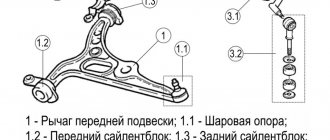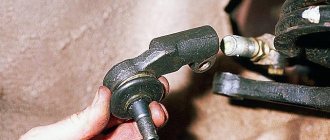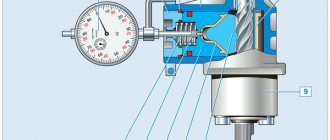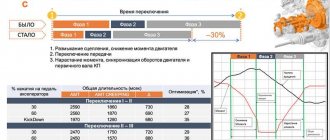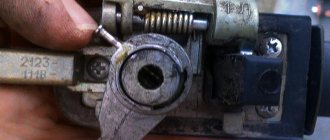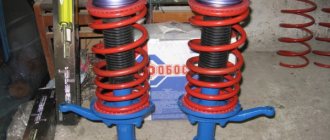Who knocked? Steering end
Of course, the goal of diagnostics is to find the faulty part and replace it. To check the condition of the tie rod end, you need to lift the car (the wheel should not touch the ground). Then it must be rocked in a special way, applying force at the “9 o’clock” or “3 o’clock” point. This swaying will allow you to feel the backlash. If it exists, you need to understand its source.
First, let's find out whether the steering tip is to blame for this. To do this, we swing the wheel in the same plane with one hand, and place the other hand behind the wheel and place it so that it touches the steering tip and the steering knuckle. If there is a gap there, you can easily feel it when rocking.
Tie rod design
In order to independently determine the degree of wear of the tips, you need to at least understand their structure in general terms. The rod is a metal rod with a thread at one end and a hinge at the other. The threaded part is used to connect to the rack or gearbox, and the ball pin is inserted into the eye of the steering knuckle and secured with a nut.
The wear of the steering tips implies the wear and tear of the hinge itself, which consists of the following parts:
- cylindrical body, closed on one side with a plug;
- a ball pin resting its lower part on the supporting heel;
- a spring is installed at the bottom between the fifth and the plug;
- An insert made of wear-resistant plastic is provided between the body and the ball;
- The top of the case is covered with a rubber or silicone cover.
Note. Depending on the design of the rods for a particular car brand, the metal rod can be welded to the hinge body or screwed onto a thread.
The plastic liner allows the ball pin to rotate in different directions, and the spring selects the play that appears during operation. When a fault is detected in the steering tips, the parts are usually replaced, preferably in pairs. There are also collapsible hinge designs that allow you to change a worn-out insert, but they are unreliable in operation.
What does this have to do with the ball joint?
There is a possibility that the gap will not be detected, although the play will be obvious. And here you should suspect problems with the ball joint. You can check whether it is really faulty in the same way as in the case of diagnosing the steering tip. It is necessary to rock the wheel by placing one hand on the ball joint. If there is a gap, it will be impossible not to notice it.
If you discover malfunctions during the diagnostics described, do not delay in replacing damaged parts. This can lead to their permanent breakdown during the trip and a serious accident. After the repair, do not forget to go to a service center to have the wheel toe angles adjusted. It is necessary!
- How to remove a wheel if the edges of a bolt or nut are torn off, see (and read) here.
Please send all questions and suggestions regarding the “Technical Environment” series of issues to:
Other episodes of “Technical Environment” are available in our special project, as well as on our YouTube channel.
Self-replacement - is it worth getting involved?
If you have a modern car with a technologically advanced steering system, it will be much easier and more convenient to contact specialists from a trusted station and get a pleasant, quick repair with minimal time and without the risk of poor-quality work. Domestic cars and budget foreign cars can be repaired in your own garage if you have a pit and experience in performing certain work. You won’t be able to do anything according to the instructions from the first video you come across, you need experience, and the help of a friend with experience in this matter will not be superfluous.
Knock in the steering rack: how to determine how to eliminate the knock
The design of a car includes dozens of different components. Some of them become unusable during operation, as evidenced by the appearance of specific sounds. One of these is a knock in the steering rack. In this article you will find useful information on how to determine the malfunction, what methods are available for diagnosing and repairing the breakdown.
How much will it cost to repair a steering rack?
If diagnostics of the malfunction showed that the steering rack needs to be replaced, then the car enthusiast will have a logical question: how much will such a pleasure cost him? It should be noted that prices for spare parts for foreign cars are an order of magnitude higher than prices for spare parts for domestic cars. Their specific values depend on the make of the car and the year of its manufacture.
So, for a VAZ car you can buy a steering rack without rods, ends and power steering for $130. The same assembled part will cost $230. To purchase a rack, the owner of a foreign car will need from 200 to 500 dollars, and the purchase of an assembled rack will require an investment of 1000-1500 dollars and more. If the car owner turns to the car service staff for help, then to the cost of the rack he will have to add the cost of paying for the services of specialists who will perform the repairs.
A few words about the steering rack
Modern rack and pinion mechanisms use two main components: the rack and the pinion. Thanks to such a simple design, the part has a long service life and is capable of properly performing its functions for more than 100 thousand kilometers. However, failure is possible, and then you will have to carry out repairs.
The operating principle of this device is also quite simple. When you turn the steering wheel, the rack begins to move in a given direction, which sets the rods in motion and also ensures that the wheels turn. It is recommended to carry out diagnostics immediately upon detecting a knock, since this component is responsible for driving the vehicle.
Sounds from the cabin
In modern cars, the steering wheel is not only needed to turn the car. It often houses controls for certain devices, from changing gears to turning on headlights or adjusting the audio system. Therefore, the driver has a natural concern when clicks appear in the steering column when turning the steering wheel. It is typical that the sound comes from inside the cabin from the area of the horn button.
In this case, there is no need to panic. First, you should check the correct installation and condition of the plastic lining of the column. The possibility of plastic deformation cannot be ruled out. A common reason for this phenomenon is a malfunction of individual elements of the steering column switch that produce such sounds. You can check the quality and fastening of the plastic, and replace the faulty switch. Often this is enough so that when you turn the steering wheel you won’t hear a click in the steering column.
Sometimes in the front part of the cabin, when you turn the steering wheel, squeaks are heard, similar to shuffling. Their source is hidden under the beep button on top of the speaker. At the same time, the signal for a problem with the airbag in the steering wheel comes on, and the cruise control buttons do not work.
We recommend: Diesel stalls when cold - causes of diesel engine malfunction
This means that the steering column cable under the airbag is inoperative. It supplies power to the mechanism of this airbag, the horn and some other devices of the car. It could simply be seriously damaged. Some motorists try to fix such faults on their own. This does not provide any guarantee of reliable operation of the cable. Taking into account the fact that this device affects safety, it is better to replace the steering column cable by experienced car service workers.
Causes of knocking
Despite its reliability, the rack design has several disadvantages. These include sensitivity to shock loads, difficulty in installation and a tendency to constant vibration. Under the influence of external loads, any component, of course, becomes unusable, which is why a characteristic knock appears.
The main reasons for this phenomenon include:
- The plastic bushing installed on the right or left side of the rack is severely worn. There is a strong backlash in the design, due to which drivers hear extraneous noise. This is especially noticeable when driving on a bad road.
- Poor tightening of connections in the steering mechanism design. It can be fixed quite simply (you need to tighten all the fasteners well).
- The appearance of corrosion, which destroys the metal and contributes to the formation of backlash.
- Damage to anthers. Dust, sand and dirt get into the structure, increasing wear of the part.
- Deformation of the crankcase, resulting in an incorrect angle between the screw and the teeth.
- Development of the resource of the central tooth.
A common problem is leakage in cars with power steering (power steering). The power steering design uses a special pump, which creates additional force when turning the steering wheel, making the process easier for the driver. When the seals fail, the pressure in the system drops, the working fluid leaks out, and accordingly, the steering wheel rotates with difficulty. As a result, this will lead to accelerated wear and knocking.
Prolonged downtime can cause the shaft to rust and difficulty turning the steering wheel, accompanied by knocking. If a hum also appears along with the knocking, this indicates a breakdown of the power steering pump. It does not build up the required pressure. The way out of the situation is to replace this component.
Most slats are made of soft metal that will wrinkle over time, so this part should be inspected regularly. Now you know why the steering rack is knocking, which means you can fix the problem.
Shock absorber struts and/or support bearings
If the cause of the knocking lies in the shock absorbers or support bearings, then there will be knocking not only when turning the steering wheel to the right/left, but also when driving in a straight line. However, during sharp turns, especially at high speed, such a knock will be more pronounced, since additional loads will be applied to the shock absorbers and bearings.
In the latter case, the cause of the knock may be a broken shock absorber spring. This usually happens at its edges (top or bottom). Accordingly, when driving on uneven roads, as well as when the car rolls in turns, the driver may hear a metallic clanging sound. When turning left - right spring, when turning right - left spring.
You can check the shock absorbers and bearings by examining them for play. To do this, you need to dismantle the wheel and shake/twist the shock absorbers and bearings. In rare cases, the knocking noise may be caused by a loose fastening nut.
Checking the steering rack
Knocking in a car can occur for several reasons. Many motorists ask how to determine a knock in the steering rack. You can do this in the following ways:
- Visually and audibly. You may hear superficial and internal knocking. The first occurs due to a ruptured boot. In this case, the tip is not protected in any way, so it quickly fails. An internal knock indicates a more serious breakdown, which is best diagnosed at a car service center.
- Check if there are any gaps in the steering rod joints.
- Disconnect the cross rods. If the knocking noise remains, then the problem is in the steering rack.
It is recommended to put the car on a lift or pit, and then ask someone to turn the steering wheel. Being directly under the car, you are more likely to be able to determine the source of the sound.
When purchasing a used car, diagnostics can become more complicated. The damage will be difficult to determine, since the previous owner may have completely replaced the boots with new ones, leaving the underlying problem without a solution. In such situations, it is better to completely dismantle the entire structure.
Subframe (atypical situations)
Sometimes atypical situations that are quite difficult to diagnose lead to knocking when turning. For example, there is a known case when, while the car was moving, a small stone hit the subframe and got stuck there. When you turn the steering wheel in one direction or the other, a natural displacement of the steering gear elements occurs, and they seem to run over this stone. When the elements were restored to their original position, they jumped off the stone, making a characteristic sound. The problem was solved by removing the stone.
When repairing suspension elements, for example, when replacing the front arm, the latter may touch the subframe when turning the wheel. Naturally, this is accompanied by a blow and a grinding sound. To get rid of it, it was enough to lift the subframe using a pry bar.
If you frequently drive on poorly paved roads, it is useful to periodically inspect the suspension and steering components. This will allow you to diagnose a breakdown at an early stage, and therefore save on subsequent repairs.
Another atypical situation of knocking in the suspension when turning is that the subframe bolt loosens, and the subframe itself can knock when driving, and even more so when turning. It can be eliminated by tightening the corresponding bolt.
Repair or complete replacement
If funds allow, then it is worth purchasing new parts, as they guarantee maximum service life. However, the cost of the gearbox is quite high. There is always a temptation to buy non-original parts. Sometimes they will not be inferior in quality to products from the official manufacturer, but there is always a chance to stumble upon a low-quality product.
An alternative option is to make high-quality repairs. To do this, a special repair kit is purchased, and then the oil seals, anthers and other components are replaced. If you have some experience in car repairs, then you can do it yourself. Otherwise, it is naturally recommended to contact a specialized auto repair shop. Repairing a power steering system is difficult, so it must be done by highly qualified craftsmen.
When is it time to change tie rods and ends? The main signs of breakdowns
Sometimes we drive a faulty car and put up with it, without even knowing about the presence of a breakdown. This is unsafe, since the manufacturer has provided complete protection against unexpected reactions of the car on the road only if everything works efficiently and properly. Therefore, you should carefully monitor the main components of the vehicle and do not forget that sometimes the car needs repairs. Otherwise, you will greatly regret that you did not make a high-quality diagnosis and did not replace the part on time. Many accidents in Russia occur precisely because vehicles have not been serviced for years. Every year it is worth undergoing a complete diagnostic of the chassis and steering at least once. It would also be useful to diagnose the power unit for sensor errors and various software glitches in the firmware.
Repair procedure
Having purchased the necessary repair kit, you can begin dismantling. Here it is necessary to follow a certain algorithm consisting of the following steps:
- Completely dismantle the steering rack.
- Remove the tie rods.
- Clean the structure from dirt accumulated during operation.
- Replace worn parts.
- Inspect the shaft and install a new one if necessary.
Why remove the tie rods? This will greatly simplify the process of installing new boots. By pulling them onto the corresponding protrusions on the rod, you can achieve maximum tightness. Before assembling the rack, be sure to lubricate the internal oil seal.
If your car has a hydraulic booster, then you will first need to disconnect the high pressure pipes and then drain the working fluid into a prepared container. It is not recommended to remove the gearbox with hydraulic power steering yourself. The procedure involves dismantling the subframe, and it is impossible to do it alone.
The described technique will eliminate knocking in the steering rack. To complete the procedure, you will need a set of keys and screwdrivers, a garage with a pit. You can also always contact a car service center, where all the above operations will be performed by auto mechanics. But be careful, as they may jack up the cost of repairs or supply low-quality consumables.
Fault diagnosis: how to do it yourself?
You can diagnose the problem yourself, or contact a car service center for help. Diagnostics will determine whether the unit can be repaired or will need to be replaced. Diagnostics are carried out in the inspection pit with the engine turned off. To diagnose yourself, you need to follow these steps:
- turn off the engine, put the car on the handbrake or put an assistant behind the wheel;
- climb down, closer to the place where the rail is located;
- ask an assistant to alternately turn the steering wheel right and left until it stops;
- try to determine where the knocking is coming from;
- inspect the steering rod joints for gaps;
- inspect the protective boots for damage and lubricant leaks;
- begin repairing detected faults.
If self-diagnosis does not allow you to identify the malfunction, you should contact a car service center for help.
If the steering rack is knocking, is it okay to drive?
Of course, your car will drive a certain number of kilometers with a knock, but it’s not worth taking risks and continuing to drive with it. In the worst case, the steering mechanism may simply jam. If this happens at high speed, the consequences will be dire.
Protect yourself and other road users. If knocking or humming occurs in the structure, be sure to carry out diagnostics or contact a service station. On some cars, due to the nature of the suspension, a slight knock in the rack may be quite normal. You can get detailed information about the problem for your make and model of car on thematic forums on the Internet.
Troubleshooting a Toyota
Despite the Japanese quality, the Toyota Corolla steering rack often makes a knocking noise. And car enthusiasts have to solve this problem. These cars are very popular in Russia. Every now and then, car enthusiasts have to decide how to remove steering rack knock. The Toyota Corolla interests them most. Previously, it was very difficult to eliminate this problem, but thanks to the experts, a solution was finally found.
You need to purchase 6 or 8 grease fittings, high-quality lubricant and be patient in your work. It is best to carry out work in a garage in a pit.
Next, in order to eliminate the knocking of the steering rack, the Toyota Corolla is placed on a flat surface. Armed with a drill of the required diameter and a drill, you need to drill a hole in the rack so that it is convenient not only to turn the grease nipple, but also to fill the rack with lubricant using a syringe.
The thread for the grease nipple is cut using a tap. After this, you must use a special sealant that is only suitable for threaded connections. Once it is applied, you need to screw the grease nipple into the hole and pack the grease into the rail.
To completely remove knocks, you will need one 400 ml bottle. It is worth remembering that after injection, it is necessary to remove excess lubricant and close the oil can with a plastic cap.
You should only use lubricant that is suitable for the racks of Toyota vehicles. In this simple way, you can eliminate a knock in the steering rack (Toyota Tundra, among others).
In other cases, on these vehicles the steering mechanism or the pipe responsible for adjusting the height of the steering wheel knocks. The mechanism must be diagnosed for existing play in the crosspiece.
HOW TO PROTECT THE STEERING RACK FROM DAMAGE?
To prevent the steering rack from knocking, you need to choose the most smooth and calm driving style. This precaution will extend the life of the part for many years. You should also refrain from emergency braking or accelerating too quickly.
When parking, you should avoid hitting the wheels on the curb. Such impacts damage the steering rack, and it begins to knock. Don't forget about periodic maintenance.
Try to drive only on good roads, avoiding problem areas. This will extend the life of not only the steering rack, but also the entire car. If you hear something knocking, immediately begin diagnosing and repairing it.
Why do tie rod ends fail quickly?
The most common defects in steering tips are a breakthrough of the rubber boot, wear of the plastic bushing or spherical surface of the pin, and weakening of the spring.
A damaged boot can cause contamination and wear on the pivot joint.
The main reasons for premature wear of steering tips during operation:
- Aggressive driving style - sharp turns of the steering wheel and active maneuvering on uneven roads.
- Driving on poor-quality surfaces, combined with a turn, hitting high obstacles (curbs, logs).
- Rotating the steering wheel on a stationary car.
- Exposure to chemically aggressive compounds.
- Frequent temperature changes.
Damage to the liner sometimes results from unqualified replacement of the part at a service station. Violation of the integrity of the boot or its displacement due to the destruction of the locking ring often causes contamination and rapid wear of the hinge.
The greatest loads on the steering tips occur when driving quickly on uneven roads with active maneuvering. When turning the wheels of a stationary vehicle, the load on the steering system elements will increase to 1 ton. With a measured driving style on good roads, tie rod ends last up to 100,000 km . With a combination of at least three of the above risk factors, symptoms of faulty steering tips may appear after 20–30 thousand km, and in the case of mechanical damage to the boot cover even faster.
general information
Even those motorists who refuse to regularly inspect their vehicle turn to specialists for help when they hear a knock in the rack. Almost all drivers know that an extraneous sound when driving is a sure sign of a steering problem.
The knock is heard from below the car, and the emanating vibrations are transmitted to the steering wheel. This breakdown is very serious, so you should start fixing it as quickly as possible.
The last resort is to completely replace the steering element, which entails significant financial costs. However, in most situations, replacement of the unit is not necessary - a small repair is enough.
